Can I Put a Trampoline in My Basement? (Is it Good Idea?)
When we think of trampolines, we mostly think outdoors. But not everyone has the luxury of a large yard behind their house.
I know a couple of friends who live in a cramped neighborhood with no space out back. Does that mean you can never give your kids the joy of having a trampoline? Well, not if I can help it.
If you cannot find space for an outdoor trampoline, why not get an indoor trampoline and put it in your basement? Is that a viable option? Let’s look at the answers below!
Can I Put a Trampoline in My Basement?
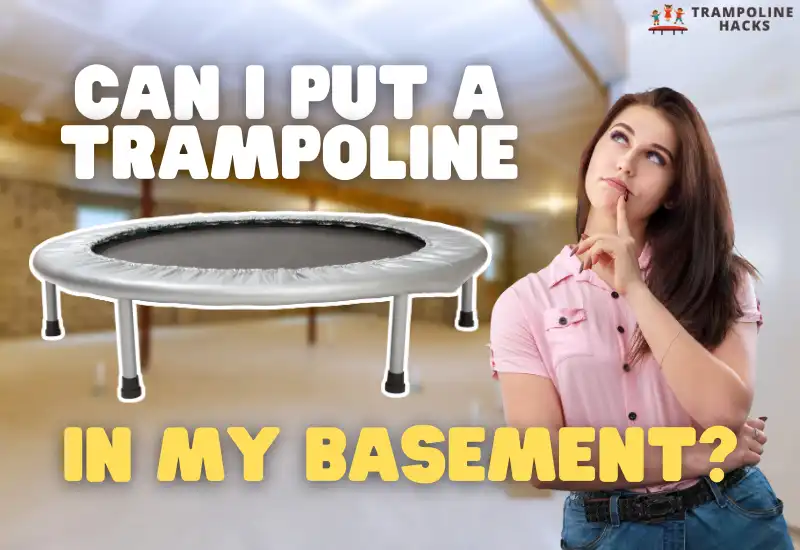
Check How to keep birds off a trampoline
Let me get it out of the way right now – you can, in fact, put a trampoline in the basement.
There are many trampolines that are designed specifically for that. But unfortunately, they will not give you the same level of jump height as a normal trampoline that you would use outdoors.
But the jump height is not the only concern if you want to put a trampoline in the basement.
In fact, the lower jump height can be a blessing in disguise as it prevents your kids from bumping their heads into the ceiling when they are using it.
While you do want your kids to enjoy themselves on the trampoline, you do not want to put them in harm’s way. And putting a trampoline in the basement naturally brings with it a couple of major safety questions.
- Is there any risk of accidents?
- What type of trampoline works in the basement?
- And can I, as an adult, jump on it too?
In this article, I will address all of these questions and help you understand the dos and don’ts of putting a trampoline in your basement.
Safety Concerns with Putting a Trampoline in the Basement
Suppose you do decide to put a trampoline in the basement, then good for you. However, there are a couple of safety issues that you need to know about. After all, safety should be your number one priority regardless of whether you decide to put your trampoline inside or outside.
So let me talk a bit about the major safety concerns with putting a trampoline in the basement and how you can get around it.
Check Can you put soap on your trampoline
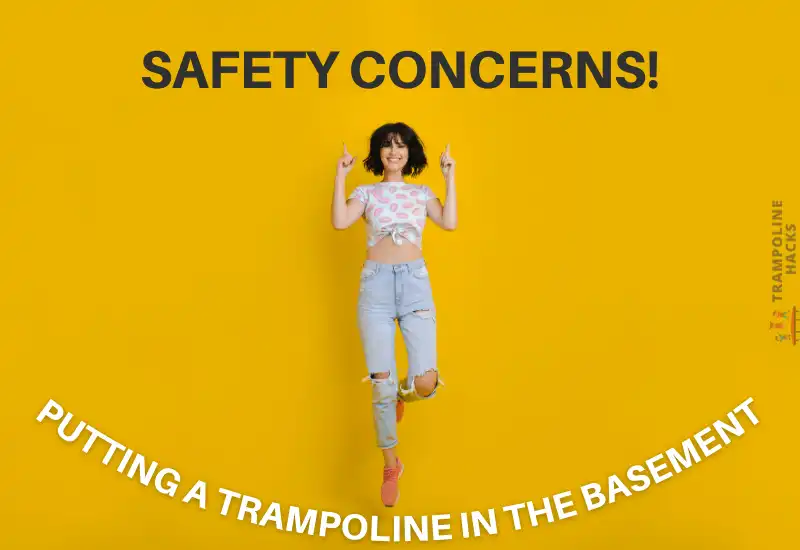
- Clearance Issues
The first thing you need to think about when setting up a trampoline in the basement is the clearance around it.
Even a small indoor trampoline takes a decent bit of space around it to set it up safely. And if your basement is short on space, you might not be able to use it there.
You need to check the area both around and above the trampoline to make sure your kids don’t bump into anything when they are jumping on it.
If there are overhanging light fixtures in your basement, you might want to consider taking them down and using different light sources for a safe jumping experience.
- Weight Capacity and Size
If you are getting it for one kid only, then weight capacity might not be a major issue to think about. Most indoor trampolines can carry at least 100 pounds which should be fine.
Check Can grass grow under a trampoline
However, for two or three kids, it becomes an important factor to consider when choosing your trampoline.
On the same note, you also want to think about the jumping area of the trampoline.
For a single child, a 40 to 50-inch trampoline might suffice. But for two or three kids, you might have a better experience with a 60-inch indoor trampoline.
- Safety Nets
Safety nets are a must whether the trampoline is inside or outside. I have seen many users set up a trampoline inside their home or basement without safety nets.
Their logic is that since an indoor trampoline does not bounce as high, safety nets are not all that important.
However, that line of thought is extremely dangerous, especially if you put it in your basement. If someone falls out of the trampoline awkwardly, it will hurt them. It does not matter whether the trampoline is inside or outside.
- Stability and Floor Type
Putting a trampoline on a concrete floor is really not a wise idea. But sadly, most basements come with concrete flooring, which can be a major safety concern if you are planning to put a trampoline there.
Check How much weight can a trampoline hold
If your basement has a concrete floor, make sure you place something under the trampoline to make the floor softer. My suggestion would be to line up the basement floor with a soft carpet that will break the fall if your kids accidentally fall off the trampoline.
Indoor Trampoline for Basement Suggestion
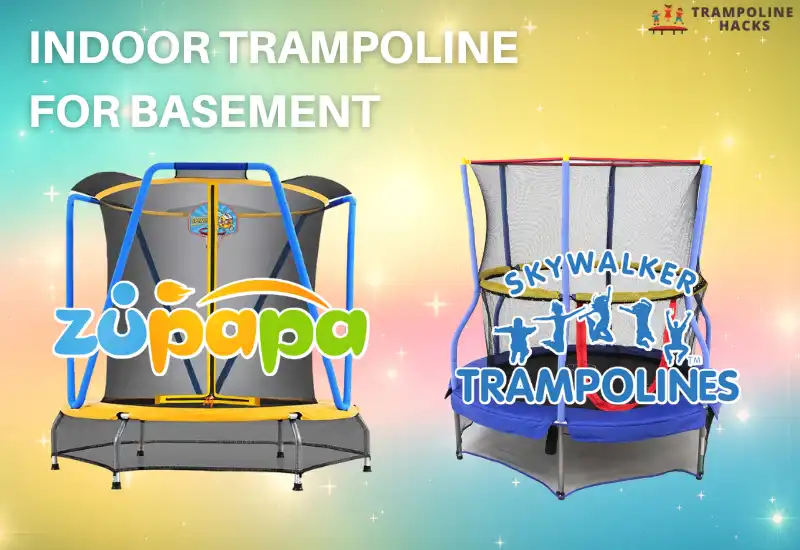
Not sure which indoor trampoline can live up to your expectations? Honestly, no single trampoline can tick all the right boxes. But some are better than others. So, here’s a quick suggestion for people who are concerned.
- Skywalker Mini Trampoline with Enclosure Net: (Buy on Amazon)
- Zupapa No-Gap Kids Small Trampoline with Net: (Buy on Amazon)
Skywalker Trampolines Mini Trampoline with Enclosure Net
When it comes to indoor trampolines, there are a couple of great options out there.
Still, if I had to pick one, I would have to go with the Skywalker Trampolines Mini Bouncer.
From top-notch safety features to fantastic durability and a good brand name to boot, this trampoline has everything that you could want from it.
This trampoline is available in multiple color options and three different sizes. The biggest one is around 60 inches which are perfect for kids up to 8 years old.
But for younger children, the 40 and 48 inches options work just as well.
Instead of going with steel springs, the manufacturer used bungee ropes to protect your children against injuries. The jumping mat is made out of Polypropylene, while there are PVC pads surrounding the frame.
I also love the powder-coated steel frame of the trampoline, which promises fantastic durability and lasting performance.
The 360-degree handlebar on the trampoline helps your kids keep their balance when they are jumping on it to prevent any awkward falls and sprained ankles.
Despite its rugged design, the price of the trampoline is surprisingly low at around 150 bucks.
Skywalker gives you three years of frame warranty and one year of parts warranty which shows you how confident they are of the quality of this trampoline.
While the Skywalker trampoline is a great pickup, it has a low weight capacity of around 100 pounds. This is not a complete deal breaker in any way, but it does put a small dent in its appeal.
If you want to get a trampoline for two or more kids, the Zupapa Kids Small Trampoline might be a better fit thanks to its 160 pounds weight capacity, which is a fair bit higher than Skywalker.
It is also a bit more affordable and gives you around 55 inches of jumping surface. Either one of these trampolines can be a valid choice if you want to put it in your basement.
Is Using an Indoor Trampoline in the Basement a Good Idea?
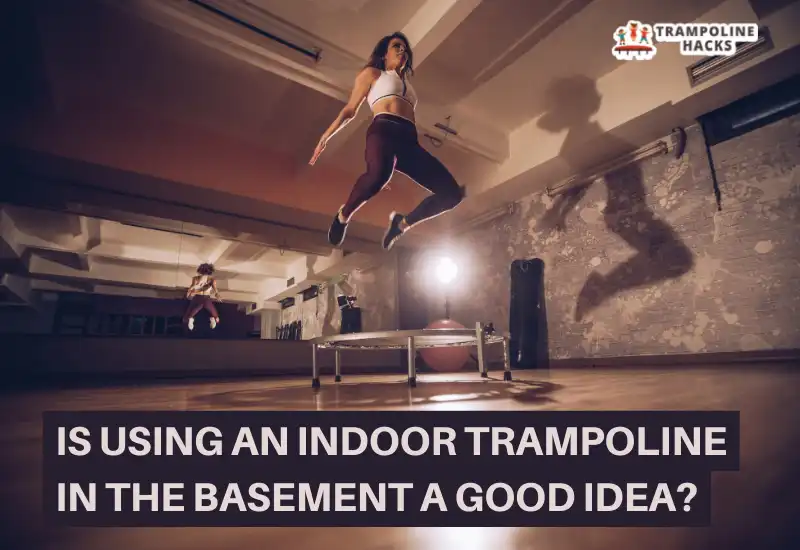
Well, frankly, it depends. If you do not have a large backyard that can support an outdoor trampoline or just want to give your kids something to play with on a rainy day, then keeping a small indoor trampoline in the basement might be a good thought.
But as I explained already, there are a couple of major safety issues to think about.
The good thing is that typically, a basement should have a high enough ceiling that overhead clearance will not be a major problem. And if your basement is spacious enough, you might be fine with putting a trampoline in it.
The last thing you want is to cram it down in a tight basement, though. A trampoline requires a bit of space around it for it to be safe. And since this trampoline would most likely be used by your kids, you want it to be as safe as it can be. So, use your best judgment before you put a trampoline in your basement.
Can I Put a Trampoline Indoors?
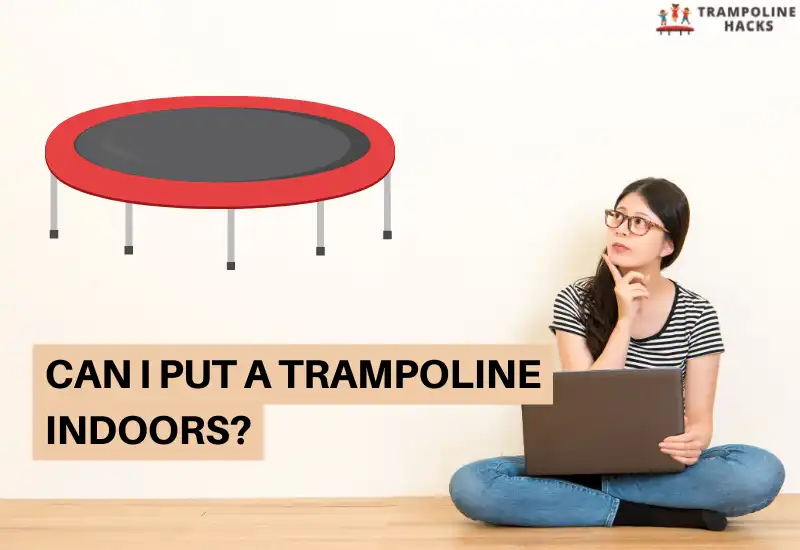
Yes, while a trampoline might be considered an outdoor toy, there are some models that are specifically designed to go indoors.
The most common example that comes to mind is a rebounder which is essentially a mini trampoline that is used mainly for some lightweight trampoline exercises.
However, mini trampolines are typically meant for adults who want to use them for rebounding exercises, not for kids to jump and bounce on. And if you want to give your kids the experience of a true outdoor trampoline while they are indoors, a rebounder is not the way to go.
Don’t worry; you still have a couple of good options in that regard. However, keep in mind that indoor trampolines rarely bounce as high as outdoor trampolines.
This is not necessarily a bad thing, though. Can you imagine if your indoor trampoline allowed you to bounce as high as an outdoor model? It would not be safe for the kids at all.
Regardless, they do offer a decent bit of bounce, and for young kids or toddlers, they can be a great choice.
They are typically a lot smaller compared to outdoor models but still include a pretty decent safety enclosure to keep the kids inside even if they lose their balance.
Can I Put an Outdoor Trampoline Indoors?
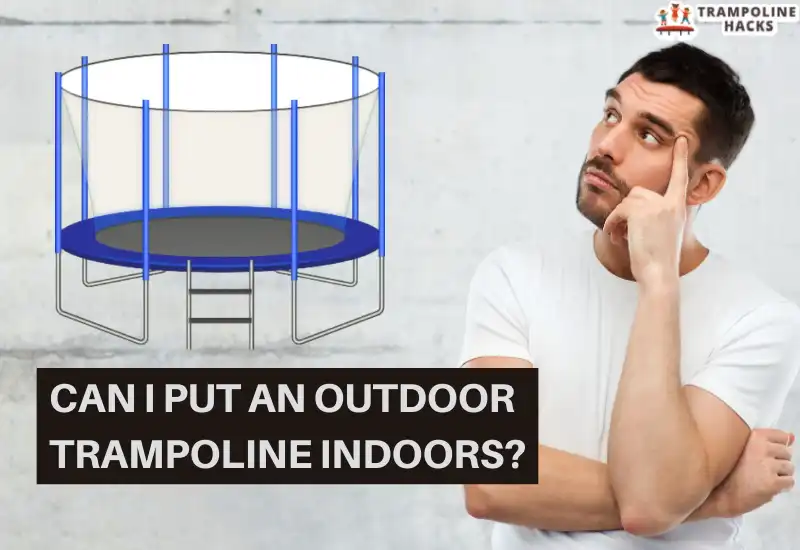
Outdoor trampolines are typically not designed the same way as indoor trampolines. While outdoor trampolines do come in small form-factor, there are a lot of larger models available.
However, an indoor trampoline is almost always smaller than 60 inches so that you can put it inside your house without any space issues.
Furthermore, outdoor trampolines feature heavier and longer springs compared to indoor trampolines. This allows you to jump higher when you are using an outdoor trampoline.
However, with indoor trampolines, manufacturers go with smaller springs to ensure you do not jump too high. Otherwise, there is a risk of you jumping up and hitting your head on the ceiling.
So even though you might be able to fit a smaller outdoor trampoline inside your house, using it as an indoor trampoline in your basement is really not a good idea. You open yourself up to a lot of risks which, if you ask me, is really not worth it.
For a safer and overall better experience, you should go with a trampoline specifically designed to be used indoors. These trampolines might not allow your kids to bounce too high, but they will let them have a fun time if you do not have an outdoor trampoline.
You can even install a basketball hoop on indoor trampolines if you want to make things even more exciting. This will give your kids something extra to do apart from just hopping on the trampoline aimlessly.
Can Adults jump on Indoor Trampolines?

Indoor trampolines are typically not designed for adults unless you are talking about rebounders. So, it is a safe bet that you cannot jump on an indoor trampoline. Typically, indoor trampolines, the ones designed for kids anyways, have a lower weight capacity compared to outdoor trampolines.
If you decide to take it for a spin, you might just rip open the trampoline mat, ruining the trampoline altogether. I think it is a better idea to let the kids have it and get yourself a proper outdoor model if you want to go for a jump.
However, you can still use rebounders if your main goal is to get a solid workout. Mini trampolines are designed specifically for this purpose and can be a great choice indoors. Similar to indoor trampolines for kids, the jump height with rebounders is not that high. But you can get a good amount of calorie burn with it.
With All Said and Done
Indoor trampolines can be a great pick-up if you want a trampoline in your basement. They are as safe as they could be, and while they don’t give your kids the true freedom of jumping outdoors, it does give them something fun to keep themselves busy.
So, if you want to put a trampoline in the basement, go for it. Just make sure you are taking all the precautions to prevent accidents while at it. Good luck!
Hi, It’s Jason and Louise here and welcome to our website. We are parents to Hannah and Zachary who absolutely love the outdoors and are actually addicted to jumping on their trampoline. Our amazing little family lives on a beautiful 20-hectare rural property with Horses, Dogs, Cats, Chooks, a Rooster, Cats and also a Pet Kangaroo.
